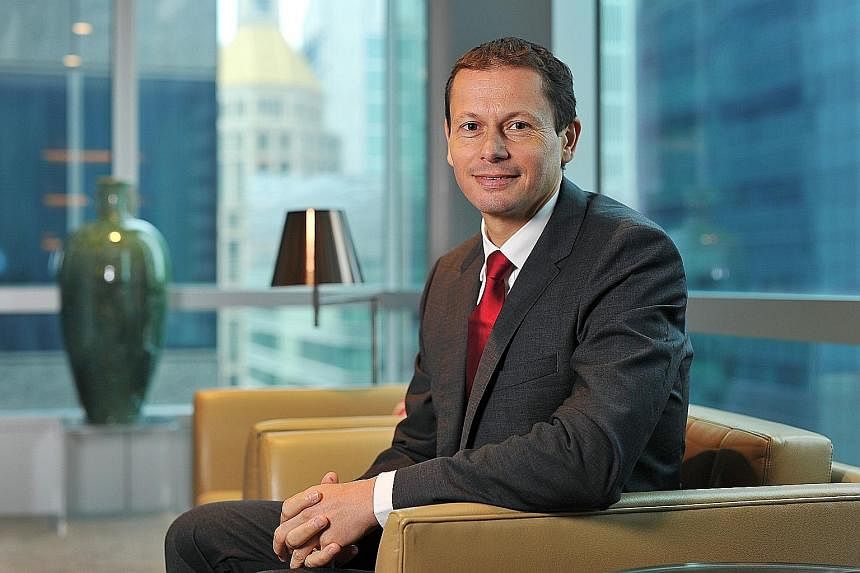THE financial industry wants the slow pace of capital market integration across South-east Asia ramped up to facilitate better fund flows, said a leading investment banker yesterday.
Mr Steven Billiet, JPMorgan Asset Management chief executive for Singapore, told The Straits Times in an interview that Asean's Collective Investment Scheme has gained little traction.
The initiative was launched last August to streamline the authorisation process for a fund manager to sell products across borders.
"The intention behind it is fantastic, but today we only have seven funds registered under the scheme. Certain things are still not in place - tax treatment, restriction on capital movements, a lack of standardised local regulatory framework, to name a few.
"The industry is more than happy to participate in the region's financial market integration, but in practice it's been proving difficult. There are more areas that regulators can look at, and more progress that can be made."
His remarks followed similar comments made last week by Monetary Authority of Singapore managing director Ravi Menon, who said the pace of financial integration in South-east Asia was "disappointing".
Cross-border regulatory hurdles were the main reason JPMorgan Asset Management could not record stronger growth in Indonesia despite the enormous market size, noted Mr Billiet.
"It's a market where we can't do much. Onshore asset managers there can only invest up to 15 per cent of their fund assets overseas. There's still very tight control on that market from an offshore point of view, and even if you're onshore, your investments are limited to domestic assets."
But the hurdles have not stopped the firm, which covers South-east Asia from its Singapore headquarters, from racking up good growth over the past 12 months.
"As a relatively new market entrant, we're still in a high growth phase," he said. "On the fund side, we grew our AUM (assets under management) by 60 per cent in the first six months of this year. In terms of market share, our mixed-asset fund market share was up by 35 per cent in 2014 in Singapore."
He declined to provide absolute figures, but mixed-asset net fund flows were around $1.5 billion in Singapore last year, according to Investment Management Association of Singapore (Imas) data. That would put JPMorgan's mixed-asset AUM at more than $500 million.
Its growth has been driven by strong demand for multi-asset funds, which accumulated a further $703.29 million of net flows in just the first quarter of this year, Imas data shows.
Mr Billiet believes the firm's capabilities in multi-asset investment will position it for further growth amid the uncertainties that persist in the investment environment.
"With the United States planning to hike the interest rate this year while the Greek debt crisis enters crunch time, there's a lot more volatility to a lot of asset classes. This is definitely not a time to be overly concentrated."
JPMorgan Asset Management was recently named the best fund provider in the multi-asset solutions category by Asian Private Banker.
"We're happy to see that a very large part of our growth has been driven by the popularity of our multi-asset funds," said Mr Billiet. "These are capabilities that we believe will create long-term stability both to our clients' investments and to ourselves as a business."
Multi-asset funds invest in a diversified portfolio of income-generating assets, including equities and fixed-income securities, across multiple geographies, with frequently adjusted asset allocation to reflect market and economic themes.
"We are still overweight on global equities, but there're lots of nuances in there and we're definitely not positive right across the board.
"In Asia, China's great rally has seen some tapering of late, and valuations that were cheap have been lifted by strong flows into the market," he said.
"What's critical now is that Chinese companies need to deliver improved earnings for their share prices to grow further or at least to sustain. You need not stay away from that market, but we are neutral on China for now."
He suggested that an ideal income-generating portfolio will have around 60 per cent in equities. Fixed-income plays are still viable, but flexibility and caution are key, particularly in Asia amid currency volatilities.
"We prefer an unconstrained strategy whereby you can be flexible and selective on credit and currencies, sometimes hedging the currency risks, especially for the weaker economies, in light of the stronger US dollar."


